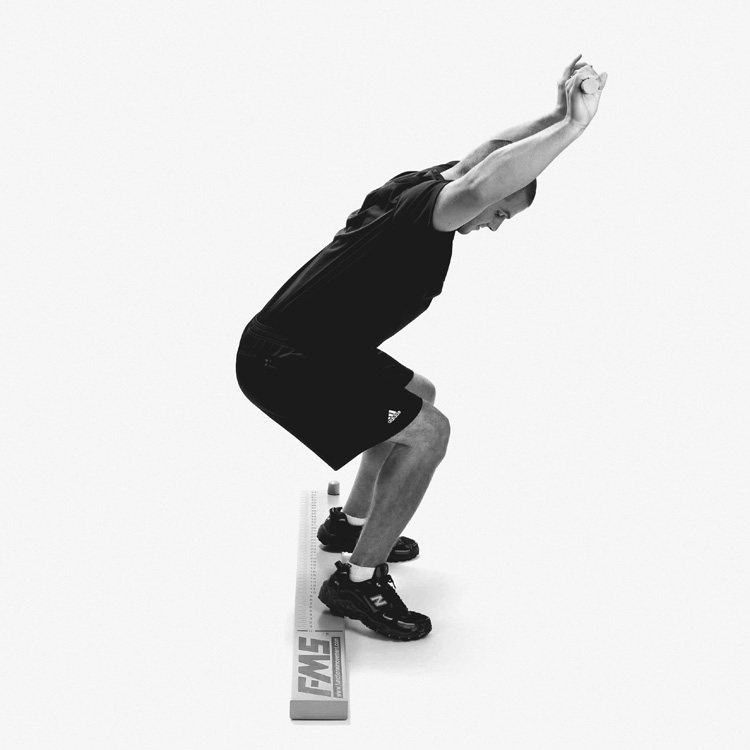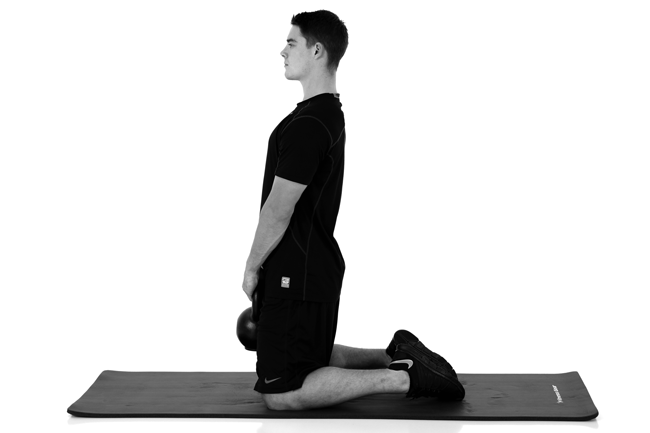FMS: Summary of Literature Reviews
The Functional Movement Screen was developed in its current form over a decade ago and has gained support in the fitness community as a way to efficiently screen and develop a corrective exercise program to improve movement patterns. As the tool has gained in popularity clinically, research has begun to be conducted that has added to the support of the screening tool. Current research on the Functional Movement Screen suggests that the test is a reliable way to objectively measure fundamental movement patterns that are modifiable and indicative of an elevated likelihood of sustaining a musculoskeletal injury.
Reliability of the Functional Movement Screen has been established between and within raters across multiple studies examining the 21 point screen (Minick et al., 2010; Frohm et al., 2011; Onate et al., 2012; Teyhen et al., 2012; Gribble et al., in press; Smith et al., in press) and the newly developed 100 point screen (Butler et al., 2012). These studies have revealed high reliability between raters who have been trained in the Functional Movement Screen, even with minimal training (4 hours) using videotaped as well as real time scoring methods. At this point, the 21 point test is recommended for fundamental screening purposes and corrective exercise prescription and can be used reliably between individuals who are trained on the screen. The use of the 100 point FMS has been recommended in a research setting to improve precision of the screen but it has yet to be utilized in an injury prediction study (Butler et al., 2012). An initial analysis suggests a strong correlation between the 21 point and 100 point FMS (r2= 0.52, unpublished).
Normative values on the movement screen have been established in active adult populations (Schnieders et al., 2011, Bhk et al., in press). These studies have also been helpful in understanding what individual characteristics may be related to FMS composite scores in the population. The average score in 20-40 year olds is approximately a 15 when combining the data from the two studies. Bhk and colleagues also tested older individuals and observed approximately a 1.2 composite decrease for the 50-59 year old group and an additional 1.2 composite decrease for the 60+ group. Both studies did not observe any nominal difference between males and females. However, BMI was reported to be a significant factor as related to FMS composite score. Bhk et al. reported individuals with lower BMI exhibited approximately a 2 point improvement in FMS scores. This finding is supported by the work of Duncan and colleagues (2012) that reported that both BMI and physical activity were predictors of FMS scores in elementary aged children; however, BMI was the more dominant of the factors.
Validity of the Functional Movement Screen as an injury screening tool has been established through the use of an evidenced based cut off score as well as identifying the presence of an asymmetry during the testing. Three studies have utilized screening statistics to establish the cut off score of <= 14 as being appropriate to identify individuals who have greater odds for sustaining an injury (Kiesel et al., 2007, O’Connor et al., 2011, Butler et al., in press). Odds ratio in these studies have ranged between 2.3-8.3 in professional football players, basic training soldiers and firefighters in training. All of these studies utilized the cut point of <= 14 (Kiesel et al., 2007, O’Conner et al., 2011, Butler et al., in press). One additional study supported

these findings in college athletes however the positive likelihood ratio was not significant (Chorba et al., 2010). Additionally, one research study has validated that the presence of asymmetry on the FMS is associated with an elevated risk for injury in professional football players (Kiesel et al., in review). Other research examining the cut score of the FMS has suggested that failure on the FMS, operationally defined as <= 16 in this study, in firefighters was strongly associated with an injury in the previous year (Peate et al., 2007). The finding of a significant difference in FMS scores in those with a prior injury was not observed in active adults (Schneiders et al., 2011). The difference between these studies is likely associated with the difference in the common magnitude of injuries in firefighters as opposed to a general population. Future research is needed with large sample sizes in additional populations to understand what factors on a movement screen are relevant to identify individuals with an elevated risk of injury as well as understanding how additional tests (i.e. Y Balance Test) assist in identifying athletes with an elevated risk of injury.
While establishing the clinical validity of the screen is beneficial, it would have little clinical relevance if performance on the Functional Movement Screen was not modifiable. Three studies have reported that scores on the Functional Movement Screen can be improved with a 6 week training program (Goss et al., 2009, Cowen et al., 2010, Kiesel et al., 2010). Improvements in the composite FMS score ranged from 2.5-3.3 on average. It was interesting to note that in one study low performance on the deep squat (FMS DS = 1) was strongly associated with lack of ability to improve an individual’s score beyond the threshold that identified an elevated injury risk (Kiesel at al., 2010). An additional point of interest from this study that was no matter what subtest of the FMS was focused on for the corrective exercise progression, the largest improvements in scores were observed in the core stability tests. One study (Frost et al., 2011) has reported that FMS scores did not change across a twelve week program in firefighters in comparison to a group of firefighters who acted as a control. Differences in this result may be related to nuances in the interventions. That being said, it is likely that not all corrective exercise programming or strength and conditioning programming may results in a change in FMS scores. Research on various models of retraining has suggested that individualized attention to form and correct movement in youth basketball players can lead to greater improvements in the FMS across a standardized training period (Klusemann et al,. in press).
It is often asked how performance on the fundamental movement screen correlates with performance. To date, multiple studies have correlated performance on the Functional Movement Screen with measures of core stability and performance (Okada et al., 2010, McGill et al., in press, Clifton et al., in press). The primary take home message across these studies is that a single performance effort is not strongly correlated with FMS scores. It will be interesting to observe if this relationship is altered with the 100 point scoring system. Itwill also be interesting to see how FMS scores are related to physiologic training load to examine a potential factor related to performance durability. With large enough samples, it will also be possible to adequately examine the relationship with scores on each of the tests to see how these independent scores may also be related to performance durability.

Finally, one study bas validated performance on the Deep Squat of the FMS using motion analysis techniques (Butler et al., 2010). It was observed that individuals who scored a 3 on the FMS DS went through greater knee flexion and exhibited a greater knee extension torque than individuals who scored a 2 or 1 on the FMS DS. At the hip, it was observed that individuals who scored a 3 on the FMS DS went through greater hip flexion and produced greater hip extension torque than individuals who

scored a 1 on the FMS DS. Future research in biomechanical studies will be helpful in identifying how movement limitations in specific FMS tests correlated with biomechanical differences on higher level functional tests that require a greater amount of work and power (i.e. jumping and running).
In summary, the Functional Movement Screen is a reliable tool that can be used to identify individuals who are more likely to become injured. It has also been observed that improvement in the composite FMS score can occur through some movement related training programs. Future research should identify whether utilizing the Functional Movement Screen as a baseline for movement in a rehabilitative setting can remove the primary risk factor of the previous injury in predicting subsequent injuries. This research should also expand behind rehabilitation and hopefully reach out to being utilized during pre-season sports physicals to identify athletes with pain or movement limitations before athletic performance commences.
REFERENCES
1. Perry FP, Koehle MS. Normative Data for the Functional Movement Screen™ in middle-aged adults. J Strength Cond Res. 2012 May 3.
2. Butler RJ, Plisky PJ, Southers C, Scoma C, Kiesel KB. Biomechanical analysis of the different classifications of the Functional Movement Screen deep squat test. Sports Biomech. 2010;9: 270-9.
3. Butler RJ, Kiesel KB, Plisky PJ. Reliability of the Functional Movement Screen Using a 100-point Grading Scale. Athletic Training and Sports Health Care. 2012;4(3): 103-109.
4. Butler RJ, Contreras M, Burton LC, Plisky PJ, Kiesel KB. Modifiable Risk Factors Predict injuries in Firefighters during Training Academies. Work. in press.
5. Chorba RS, Chorba DJ, Bouillon LE, Overmyer CA, Landis JA. Use of a functional movement screening tool to determine injury risk in female collegiate athletes. N Am J Sports Phys Ther. 2010 Jun;5(2):47-54.
6. Clifton DR, Harrison BC, Hertel J, Hart JM. Relationship Between Functional Assessments and Exercise-Related Changes During Static Balance. J Strength Cond Res. 2012 Jun 11.
7. Cook G, Burton L, Hoogeboom B. Pre-Participation Screening: The Use of Fundamental Movements as an Assessment of Function – Part 1. N Am J Sports Phys Ther. 2006a; 1: 62–72.
8. Cook G, Burton L, Hoogeboom B. Pre-Participation Screening: The Use of Fundamental Movements as an Assessment of Function – Part 2. N Am J Sports Phys Ther. 2006b; 1: 132-139.
9. Cook G. Athletic body in balance – optimal movement skills and conditioning for performance. Human Kinetics, 2004, United States of America.
10. Cowen VS. Functional fitness improvements after a worksite-based yoga initiative. J Bodyw Mov Ther. 2010;14:50-4.
11. Duncan MJ, Stanley M. Functional movement is negatively associated with weight status and positively associated with physical activity in british primary school children. J Obes. 2012.
12. Frohm A, Heijne A, Kowalski J, Svensson P, Myklebust G. A nine-test screening battery for athletes: a reliability study. Scand J Med Sci Sports. 2012 Jun;22(3):306-15.
13. Frost DM, Beach TA, Callaghan JP, McGill SM. Using the Functional Movement Screen™ to evaluate the effectiveness of training. J Strength Cond Res. 2012 Jun;26(6):1620-30.
14. Goss DL, Christopher GE, Faulk RT, Moore J. Functional training program bridges rehabilitation and return to duty. J Spec Oper Med. 2009;9:29-48.
15. Gribble P, Brigle J, Pietrosimone B, Pfile K, Webster K. Intrarater Reliability of the Functional Movement Screen. J Strength Cond Res. 2012 May 15. 16. Kiesel KB, Plisky PJ, Butler RJ. Functional movement test scores improve following a standardized
off-season intervention program in professional football players. Scand J Sci Med Sports. 2011; 287-292.
17. Kiesel K, Plisky PJ, Voight M. Can serious injury in professional football be predicted by a preseason Functional Movement Screen? N Am J Sports Phys Ther. 2007; 2(3):76-81.
18. Kiesel KB, Plisky PJ, Butler RJ. Fundamental movement limitations and asymmetries relate to injury risk in professional football players. in review.
19. Klusemann MJ, Pyne DB, Fay T, Drinkwater EJ. Online-video based resistance training improves the physical capacity of junior basketball athletes. J Strength Cond Res. 2011 Nov 19.
20. O'Connor FG, Deuster PA, Davis J, Pappas CG, Knapik JJ. Functional movement screening: predicting injuries in officer candidates. Med Sci Sports Exerc. 2011 Dec;43(12):2224-30.
21. Onate JA, Dewey T, Kollock RO, Thomas KS, Van Lunen BL, DeMaio M, Ringleb SI. Real-time intersession and interrater reliability of the functional movement screen. J Strength Cond Res. 2012 Feb;26(2):408-15.
22. Parchmann CJ, McBride JM. Relationship between functional movement screen and athletic performance. J Strength Cond Res. 2011 Dec;25(12):3378-8.
23. Schneiders AG, Davidsson A, Hörman E, Sullivan SJ. Functional movement screen normative values in a young, active population. Int J Sports Phys Ther. 2011 Jun;6(2):75-82.
24. Smith CA, Chimera NJ, Wright N, Warren M. Interrater and Intrarater Reliability of the Functional Movement Screen. J Strength Cond Res. 2012 Jun 11.
25. Teyhen DS, Shaffer SW, Lorenson CL, Halfpap JP, Donofry DF, Walker MJ, Dugan JL, Childs JD. The Functional Movement Screen: a reliability study. J Orthop Sports Phys Ther. 2012 Jun;42(6):530-40.
 these findings in college athletes however the positive likelihood ratio was not significant (Chorba et al., 2010). Additionally, one research study has validated that the presence of asymmetry on the FMS is associated with an elevated risk for injury in professional football players (Kiesel et al., in review). Other research examining the cut score of the FMS has suggested that failure on the FMS, operationally defined as <= 16 in this study, in firefighters was strongly associated with an injury in the previous year (Peate et al., 2007). The finding of a significant difference in FMS scores in those with a prior injury was not observed in active adults (Schneiders et al., 2011). The difference between these studies is likely associated with the difference in the common magnitude of injuries in firefighters as opposed to a general population. Future research is needed with large sample sizes in additional populations to understand what factors on a movement screen are relevant to identify individuals with an elevated risk of injury as well as understanding how additional tests (i.e. Y Balance Test) assist in identifying athletes with an elevated risk of injury.
these findings in college athletes however the positive likelihood ratio was not significant (Chorba et al., 2010). Additionally, one research study has validated that the presence of asymmetry on the FMS is associated with an elevated risk for injury in professional football players (Kiesel et al., in review). Other research examining the cut score of the FMS has suggested that failure on the FMS, operationally defined as <= 16 in this study, in firefighters was strongly associated with an injury in the previous year (Peate et al., 2007). The finding of a significant difference in FMS scores in those with a prior injury was not observed in active adults (Schneiders et al., 2011). The difference between these studies is likely associated with the difference in the common magnitude of injuries in firefighters as opposed to a general population. Future research is needed with large sample sizes in additional populations to understand what factors on a movement screen are relevant to identify individuals with an elevated risk of injury as well as understanding how additional tests (i.e. Y Balance Test) assist in identifying athletes with an elevated risk of injury. 






